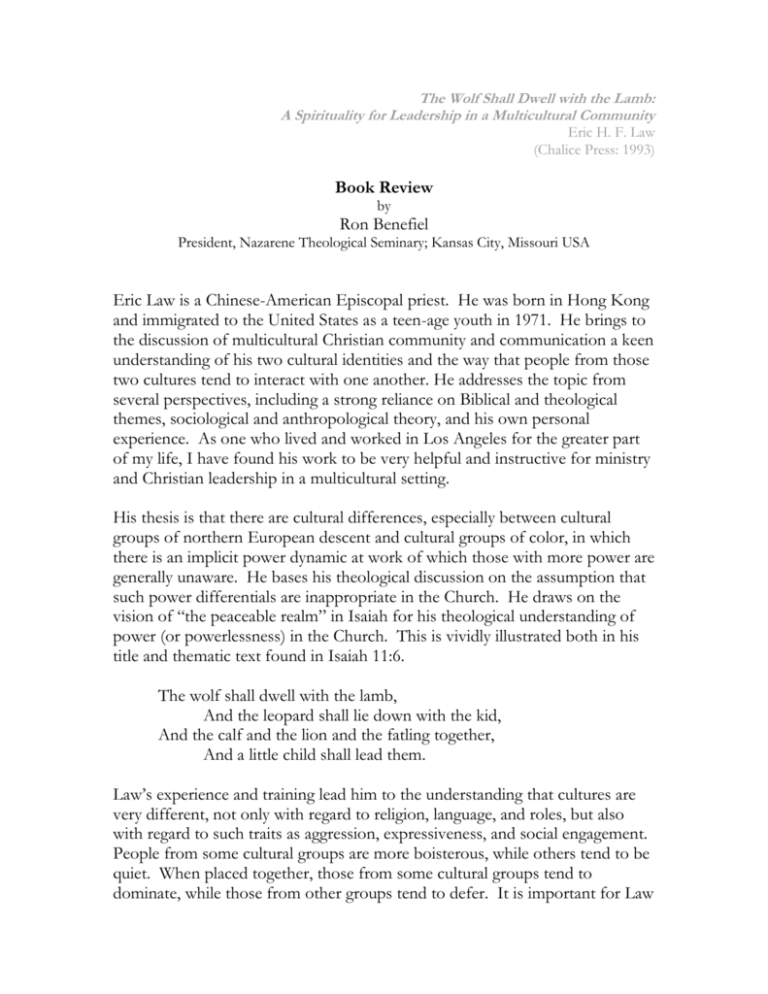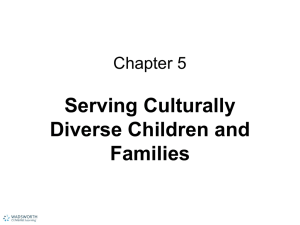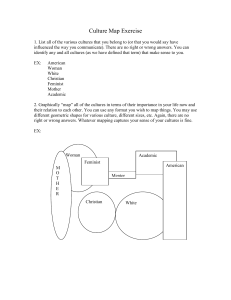A Review of Eric Law`s The Wolf Shall Dwell with the Lamb
advertisement

The Wolf Shall Dwell with the Lamb: A Spirituality for Leadership in a Multicultural Community Eric H. F. Law (Chalice Press: 1993) Book Review by Ron Benefiel President, Nazarene Theological Seminary; Kansas City, Missouri USA Eric Law is a Chinese-American Episcopal priest. He was born in Hong Kong and immigrated to the United States as a teen-age youth in 1971. He brings to the discussion of multicultural Christian community and communication a keen understanding of his two cultural identities and the way that people from those two cultures tend to interact with one another. He addresses the topic from several perspectives, including a strong reliance on Biblical and theological themes, sociological and anthropological theory, and his own personal experience. As one who lived and worked in Los Angeles for the greater part of my life, I have found his work to be very helpful and instructive for ministry and Christian leadership in a multicultural setting. His thesis is that there are cultural differences, especially between cultural groups of northern European descent and cultural groups of color, in which there is an implicit power dynamic at work of which those with more power are generally unaware. He bases his theological discussion on the assumption that such power differentials are inappropriate in the Church. He draws on the vision of “the peaceable realm” in Isaiah for his theological understanding of power (or powerlessness) in the Church. This is vividly illustrated both in his title and thematic text found in Isaiah 11:6. The wolf shall dwell with the lamb, And the leopard shall lie down with the kid, And the calf and the lion and the fatling together, And a little child shall lead them. Law’s experience and training lead him to the understanding that cultures are very different, not only with regard to religion, language, and roles, but also with regard to such traits as aggression, expressiveness, and social engagement. People from some cultural groups are more boisterous, while others tend to be quiet. When placed together, those from some cultural groups tend to dominate, while those from other groups tend to defer. It is important for Law that his readers understand that these acquired cultural characteristics, or “internal culture,” are for most people the taken-for-granted stuff of life. It is the only way they know. It is what is assumed to be appropriate and correct interaction. Any other way of thinking or acting would seem strange, curious, or even reprehensible. These instinctual cultural assumptions are the very nature of ethnocentrism. Justice is essential for the accomplishment of Law’s vision of the Church as “the peaceable realm”. He defines justice as “the equal distribution of power and privilege”. Therefore, power differentials in the Church, either explicit or implicit, need to be challenged. In “the peaceable realm,” peace is not accomplished by coercion or control, but rather by those in power relinquishing their power. For Law, true peace requires justice. To do justice is to be able to see and recognize the uneven distribution of power and take steps to change the system that has created and perpetuates the inequality. Law relies heavily on and gives credit to the 1989 work of Geert Hofstede, Culture’s Consequences: International Differences in Work-Related Values. In that work, Hofstede developed a “Power Distance Scale” drawing from his analysis of 40 different cultural groups. The idea of “power distance” is that there are different cultural understandings of how much inequality of power is appropriate within a given culture. In High Power Distance (HPD) cultures, people tend to believe there should be an order of inequality in the world. Large power differentials are an accepted part of life, both for the powerful and the powerless. These cultures tend to have little or no middle class through which inter-class mobility may occur. In contrast, in Low Power Distance (LPD) cultures most people believe that inequality in a society should be minimized. In these cultures, people with power try to appear as though they have less power than they actually have. In LPD cultures, there is usually a well-developed middle class, which facilitates greater inter-class mobility. Only people at the extremes of an LPD culture (very rich and very poor) believe the system cannot be changed to become more just. Hofstede found High Power Distance cultures to include people from the Philippines, Mexico, Venezuela, India, Singapore, Brazil, Hong Kong, France, Colombia, Turkey, Belgium, Peru, Thailand, and Chile. Hofstede’s list of Low Power Distance cultures includes people from Austria, Israel, Denmark, New Zealand, Ireland, Sweden, Norway, Finland, Switzerland, Great Britain, Germany, Australia, Netherlands, Canada, and the United States. The real value of Hofstede’s model comes in its explanation of how and why social interactions are different from one culture to the next. He observes that in HPD cultures, the authoritative figure is usually the leader. The leader typically has a good network of trusted people who give him (usually a male) the privilege of leadership, but also the information he needs to lead. In a meeting, the leader is very much in control. It is at his invitation that others in the meeting offer an opinion or information. In the final analysis, any decisions will be largely his to make. By contrast, in LPD cultures the ground rules are different. It is assumed that any person can freely enter the dialogue in a discussion or in a meeting. Informal ground rules for interaction allow for people to openly disagree without necessarily offending the person they are disagreeing with. The leader is seen as the facilitator of the group discussion. The final decision is one that the group comes to through an open process of participation. Law points out that when people from LPD and HPD cultures are in a meeting together, a whole new dynamic arises. People from LPD cultures participate in the meeting as they normally would. They assume that anyone in the meeting who has something to say will speak up and say it. People from HPD cultures, on the other hand, tend to close up. Members from HPD cultures tend to expect an authoritative leader to tell them what will happen and what they are to do. The multicultural meeting is confusing to people from both types of cultures. People from LPD cultures are perplexed as to why people from HPD cultures don’t join in the discussion. They likely will become aware at some point that members of HPD cultures are not participating and try to coax their participation by saying things like, “I think we should hear from some of the people who have not spoken up yet”. In the meantime, people from HPD cultures are confused in the meeting because people (from LPD cultures) are freely speaking without being specifically asked by the leader to speak. They typically assume that those who are speaking so freely must have a great deal of power to be able to speak as they do. This adds to their sense of intimidation and to their tendency to clam up and defer to others (LPD) in the group. LPD members, just by behaving as they normally do in meetings, are perceived as superior by people from HPD cultures. At the same time, it usually is important to LPD members that those from HPD cultures be seen and valued as equal members with an equal voice. The result creates a power dynamic that is similar to putting wolves and lambs together. People from wolf cultures (LPD) end up with more power and generally dominate. People from lamb cultures (HPD) end up with less power and generally defer. In the long run, people from HPD cultures feel unsafe and unnecessary and stop coming to the meetings. Law’s analysis is more helpful for describing the situation and diagnosing the problem than it is for offering solutions. However, he does suggest some exercises and group processes that in his experience have helped facilitate interaction in multicultural settings. One such process he calls “Mutual Invitation”. In following the ground rules for Mutual Invitation, the appointed leader introduces the process and then shares his or her opinions on the issue without projecting himself or herself as an expert. The leader then invites another member of the group to share their view. The authority is now in the hands of the second person. After that person has completed sharing, he or she invites a third member of the group to share who, after they have shared, invites another member, and so on. This process continues until everyone has had the opportunity to participate. When a member of the group is invited to share, he or she may pass but still has the privilege of selecting the next person to share. Law suggests that such a process has the effect of decentralizing the power held by the leader as well as the perceived power of members from LPD cultures. In his experience, members from LPD cultures may find the exercise to require a great deal of patience. He suggests that the discipline of patience is necessary for the development of Christian community in “the peaceable realm” where the wolf dwells with the lamb. With regard to the upcoming Global Nazarene Theology Conference, I believe Hofstede, in his theoretical model and Law, in his application of the model to the multicultural Christian community have something important to say to us. Groups at the conference may or may not decide to follow the rules of “mutual invitation” in their group discussions. Regardless, I believe that Law is correct when he says to us that inevitably there will be power dynamics at work of which those of us from LPD cultures will tend to be less aware. It seems to me that our coming together as a multicultural group of Christian theologians gathered together in Christian community will require that we be sensitive to those dynamics and find ways to challenge the perceived and real power differentials that may be present among us. I invite you to join me in prayer in anticipation of our time together.







